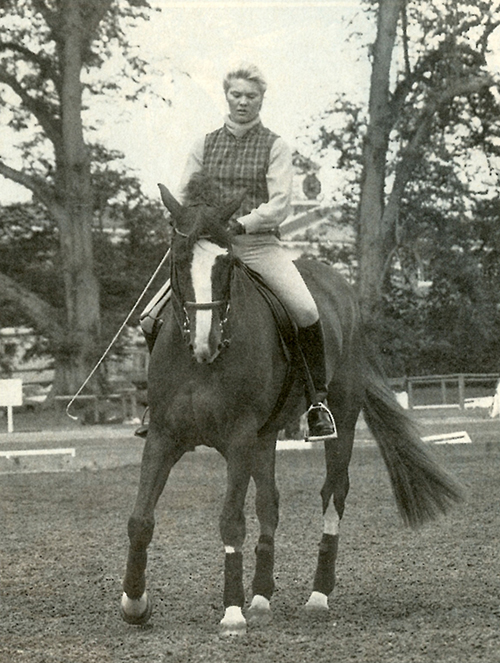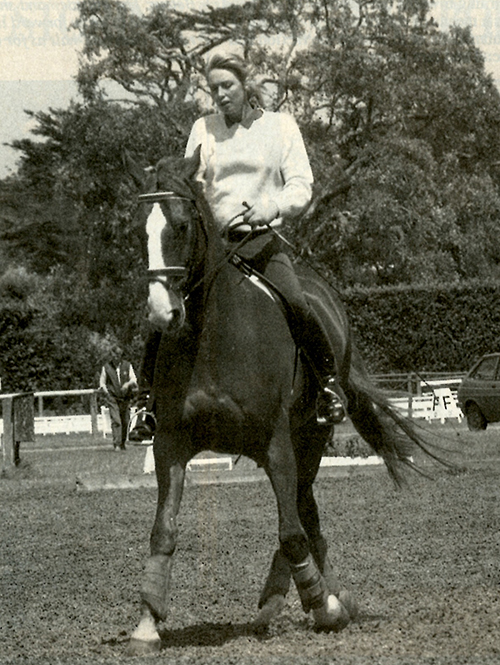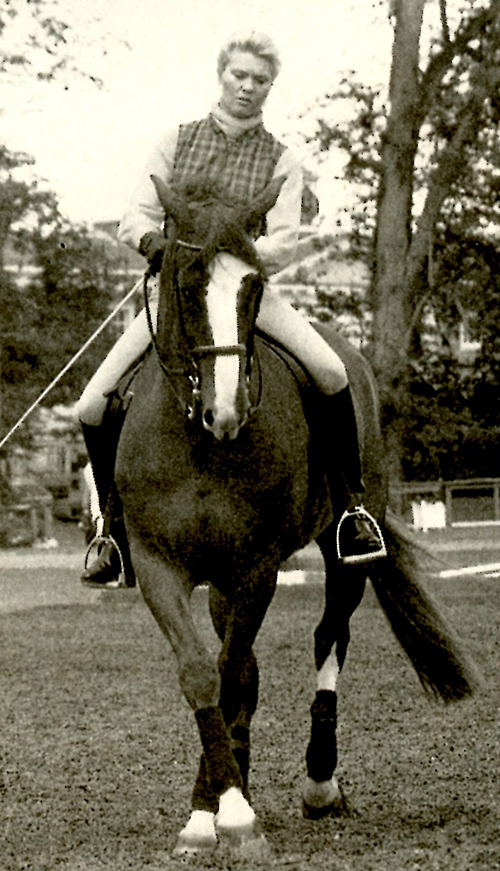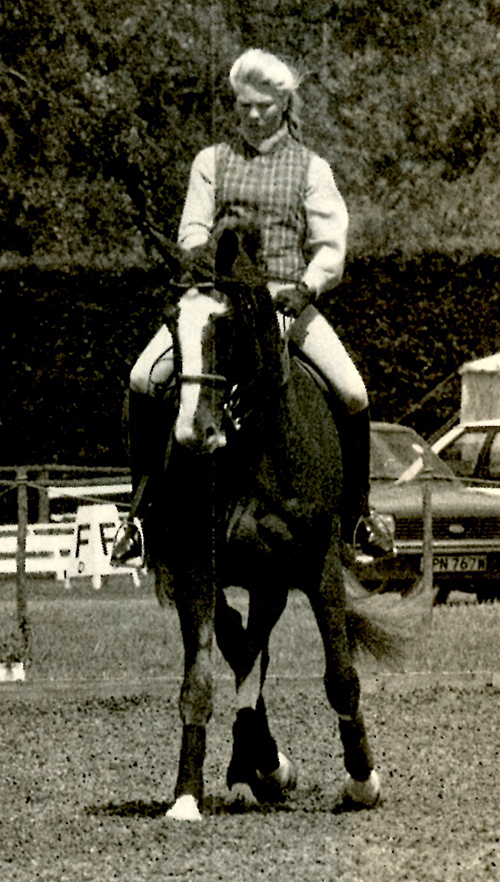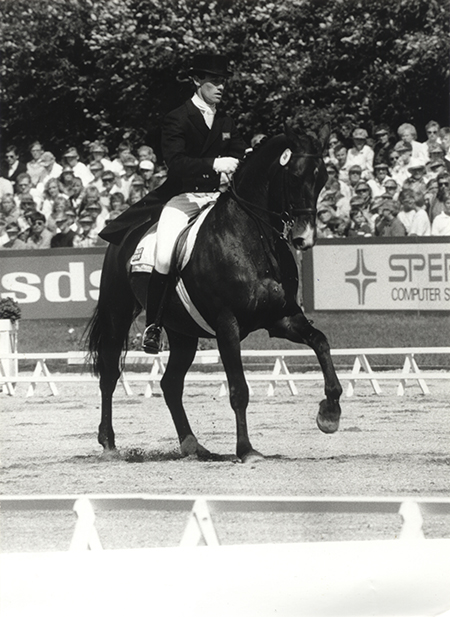
British dressage star, Christopher Bartle discusses the next step on the path to collection.
THE pirouette and half-pass and the related movements of renvers and travers represent the next step in the logical progression towards collection. During the basic work the lateral submission was achieved by asking the horse to move away from the inside leg and the bend. In the shoulder-in the horse brings the forehand in while remaining bent around the inside leg. Then in the pirouette and half-pass, the horse steps with the outside hind across and in front of the inside hind while remaining bent through his body around the rider’s inside leg with a lateral flexion at the poll to that side.
Once the shoulder-in is established reasonably well and the horse is prepared to maintain the lateral submission then the rider can ask for the pirouette and then the half pass. The important point to remember in both the pirouette and the half-pass is that the order of priorities should remain the same as before. The ability to maintain the rhythm through the movements is based on these three priorities.
The horse must be bent around the inside leg, offering the lateral flexion at the poll while remaining light on the inside rein
The horse must think forwards and accept the slowing aids or half-halts and be laterally submissive. The horse must be bent around the inside leg offering the lateral flexion at the poll while remaining light on the inside rein. This will come about if the horse is prepared to draw forward into the outside rein and respects the inside leg by coming around it rather than against it.
If the bend in the neck is obtained by pulling on the inside rein the horse will tend to resist the lateral flexion at the poll. A common rider fault in all the lateral work is for the inside rein to be too long at the start of the movement. It is well worth getting into the habit of shortening the inside rein as a matter of course in the same way as one should sit to the inside of the saddle.
Loss of Lateral Submission
Problems such as head tilting in halfpass and pirouette or not enough bend or quarters trailing or leading in the halfpass are usually due to a loss of lateral submission. Any tendency to block the lateral flexion or to come against the inside leg during the course of the movement must be corrected first. This correction needs to be as firm as necessary to achieve the lateral submission.
The rider must be prepared also to go back as far as is necessary to achieve submission. In the case of the advanced horse which has been correctly schooled, it is sufficient to apply a little more inside leg to remind the horse to respect and remain submissive to the inside leg. In the case of the horse which tends to resist more strongly, the rider should ride straight forward while working on the lateral submission. If that does not work, the rider should ride out of the movement into shoulder-in to emphasise the inside leg. If the horse still resists the lateral flexion and bend then the rider must be prepared to go back even to square one, the tum about the forehand, to re-established the lateral submission.
Problems such as not enough bend or quarters trailing are usually due to a loss of lateral submission
The Pirouette
At the moment of commencing the pirouette the rider applies a half-halt on the outside rein as the outside leg is applied at the girth to ask the forehand to come around. As the outside foreleg comes across in front of the inside foreleg, the outside hand must allow. As the leg comes to the ground the half-halt can be re-applied if the horse tries to walk forward, otherwise the hand just allows the next step. The half-halt should be applied slightly away from the neck rather than towards to prevent the outside hind leg from stepping outwards.
The important point to remember in executing the pirouette is that it is the forehand which is being asked to come around the hindquarters; therefore the outside leg should address the forehand.
A common rider fault in the pirouette is to use a backward pressure of the leg combined with a neck rein on the outside. This tends to contradict the effect of the inside leg by asking the horse to step inwards with the quarters. The application of the neck rein pulled across the neck will also tend to work against the lateral flexion to the inside.
The rider must keep an active rhythm in the mind rather like a metronome to which the horse’s walk can be related. If the horse slows the rhythm during the pirouette then the rider must animate the walk by riding the pirouette a bit more forward or if necessary by using a tap of the whip. It is a mistake to use a physically stronger pressure of leg as this will tend to pull the rider across to the wrong side of the saddle. In the case of some horses it is necessary to think of increasing the tempo slightly before the pirouette, while with other more tense horses it is necessary to slow the tempo.
Developing the Movement
The size of the steps with the forehand will initially be small with not a lot of crossing expected. Gradually, however, the horse should become more confident and supple and therefore able to maintain the same length of stride as in the collected walk. The degree of crossing will thereby increase.
When first asking the horse to execute the pirouette it is better to ask away from the wall and allow some forward movement as the forehand comes around. The rider’s inside leg which is present at the girth and around which the horse is bent must be ready to activate the inside hind but without exerting a pressure which would cause the horse to step outwards.
Gradually the increased collection of the walk and greater engagement and sustained flexion of the hind legs will enable the horse to execute a pirouette on the spot without losing the rhythm of the walk, in particular with the inside hind.
This is why this exercise is so useful as a means of teaching the horse to collect and is in fact a preparation for the piaffe as well as the half-pass.
Preparing for Half-pass
The preparations and requirements for the half-pass are much the same as for the pirouette. Once the horse is set up for the half-pass, the rider’s outside leg at the girth should apply lateral pressure in a similar way as for the pirouette. The outside hand should allow the horse to draw forward into the bend rather than half-halt as for the pirouette. This difference in action of the outside hand is virtually the only difference between the aids for the pirouette and the half-pass.
The rider must remember that it is as important that the horse steps forward as that he crosses. The inside leg must therefore not only be on the horse’s side to provide the ‘pillar’ around which he bends, but must also encourage the inside hind to step well forward. At the same time the lateral pressure of the outside leg should be slightly forwards rather than backwards.
One frequently sees confusion in tests between the understanding of the aids for half-pass and canter. This arises from the manner in which the outside leg is used. Very often one sees that the emphasis in both the canter transition and the halfpass is on the backward use of the outside leg. As explained in previous articles, the rider should ask for canter from the inside leg while keeping the outside leg at the girth. In the half-pass the outside leg is used in the direction of the movement rather than backwards.
Initially the degree to which the horse is asked to move sideways is relatively little. As the horse becomes more confident, supple and therefore collected, the angle of the half-pass can be increased. To use an increasingly strong pressure of outside leg to push the horse over will only succeed in pulling the rider over to the wrong side of the saddle and cause the horse to lose the lateral submission to the inside.
It always helps to set realistic targets in terms of the movements. This is particularly so of the half pass. In riding the half-pass from F to G, for example, it helps to imagine a wall running from F to G along which the horse will be asked to perform the travers. If the horse is brought into the travers correctly with the lateral flexion at the poll and bend around the inside leg, then his face will point towards G; the rider can concentrate on maintaining the flexion and bend, and his outside leg will ride the horse along the imaginary wall. Half-halts can be applied if the horse endeavours to cross the line, or ‘wall’.
As long as the flexion and bend are maintained correctly, the quarters will not get ahead of the shoulders or trail significantly.
As the outside foreleg comes across in front of the inside foreleg the outside hand must allow.
The outside hand should allow the horse to draw forward into the bend rather than half-halt as for the pirouette.
Variations on a Theme
When riding the half-pass from the centre line to the side, the rider should ensure that the lateral flexion and bend are maintained right up to the side and for approximately one stride along the side. The same applies when riding the horse from the side to the centre line. In addition in riding the half-pass away from the wall, the option exists to finish the exercise by riding straight and then turning towards the direction of the bend as a means of emphasising the lateral submission or to change the flexion and bend and turn the other way.
As well as half-pass from and towards the sides of the arena, the movement can be ridden along the wall as a travers with the horse facing the wall, or as a renvers with the horse facing away from the wall. The renvers exercise in trot is more useful from the point of view of promoting the lateral submission than the travers. The horse’s natural crookedness, particularly in canter, means that the travers exercise tends to accentuate that crookedness.
In conclusion, the shoulder-in, pirouette, half-pass, renvers and travers are all linked by the common bend and lateral flexion which is the main priority in all this work. The rider should vary the exercises and ride from one to the other according to the response of the horse.
Through this work the horse will become more submissive and allow the rider to increase the demands for collection.


